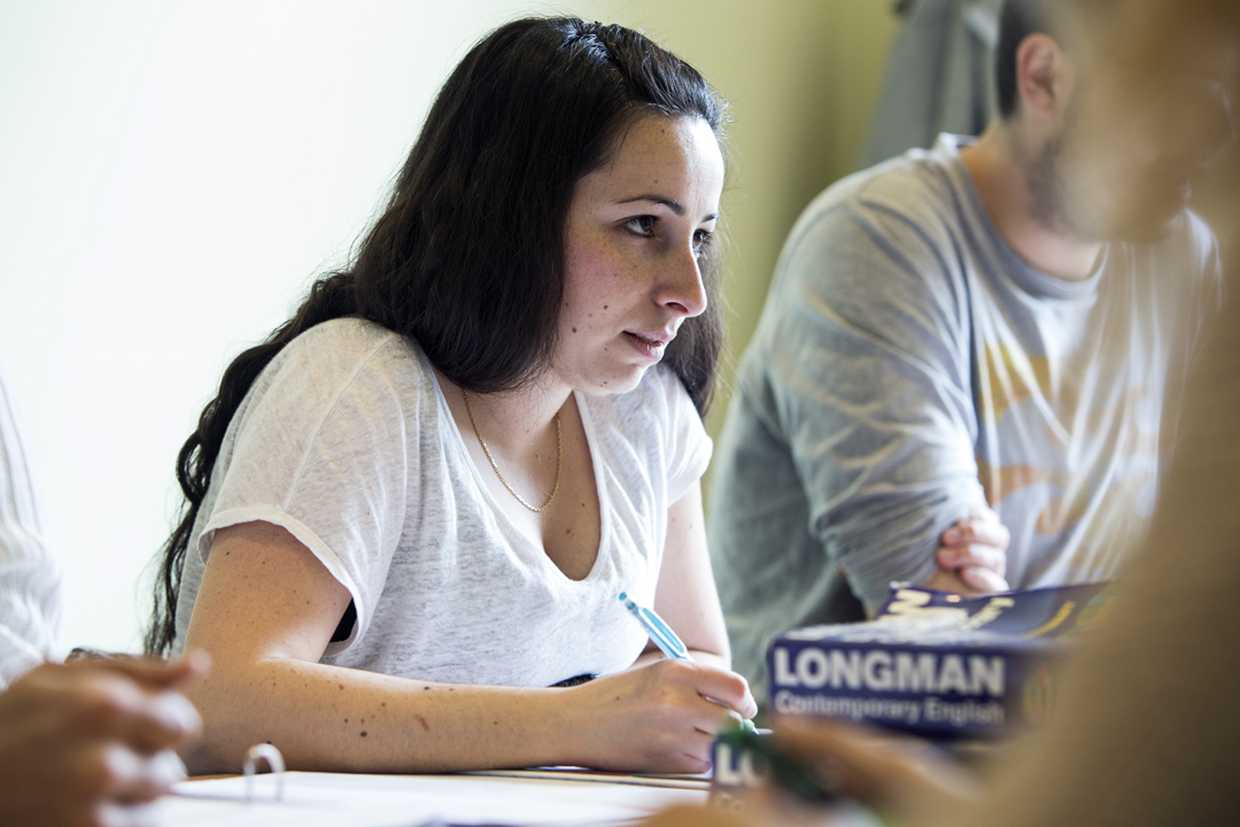The IELTS Listening section
In our fourth IELTS blog we’re going to focus on the listening test. Although this is the last part of the IELTS exam that we’re looking at, listening is actually the first part of the exam that you do (followed by reading and writing). As we did in our previous blogs, we’ll make some general comments about the listening exam first of all and then we’ll look at the different parts.

A course participant at The London School of English
Overview
- The listening test is made up of four sections, each one of which has ten questions – so in total you have to answer forty questions. Each question is worth one mark, so they are all equally important. Each section focuses on a specific type of situation, so you will have a very general idea of what to expect before you hear the recordings. The test lasts about thirty minutes.
- Sections 1 and 2 are similar in the sense that they deal with everyday situations, whereas Sections 3 and 4 are always related to the world of education and training. Section 1 is the easiest, and then they get more difficult – so section 4 is generally the hardest.
- Unfortunately, unlike in other English-language exams, you only hear the recordings once – and then they’re gone forever! As a result, you need to concentrate fully throughout the test, or you might miss something important. You can expect to hear a range of different native speaker accents on the recordings – not just British but also Australian, New Zealand, American and Canadian.
- Before you hear the recordings you are given time to read the questions. You will be told exactly how much time you have – depending on which section it is, you will have between 30 seconds and a minute. Make sure that you use this time well - read the questions carefully and identify the key words, as this will prepare you for what you’re going to hear and give you an idea of what you have to listen for.
- As you read the questions, look for clues that will tell you what type of word the answer is. Have a look at this example: "Luke has to ....................................his daughter from school." Here, the word ‘to’ tells us that the missing word is a verb. You can also use your knowledge of collocations to predict the answer – what verb goes with ‘a child from school’? The answer is probably ‘pick up’ or ‘collect’.
- A variety of question types are used in the listening test, for example multiple-choice, short-answer questions, completing notes, completing sentences, completing a table or labelling a map or a diagram. (Many of these question types also appear in the reading exam.) Each section can have a number of question types, so for example Section 2 might be a mixture of note completion, sentence completion and labelling a map. You can expect to have a range of different question types throughout the whole test.
- Look out for questions where the speaker spells something, for example the name of the street where they live. You have to get this exactly right, so be careful with letters which are easily confused such as E and I, or G and J. You should also be careful with numbers which sound similar, such as 16 and 60, ‘double’ numbers, for example a telephone number which has the numbers 77, and combinations of letters and numbers, for example a postcode in an address. These types of questions are especially common in section 1.
- When you’re reading the questions, you should pay special attention to the number of words that you are allowed to use. If, for example, you are told to write no more than two words, this means you’re not allowed to write three words. The instructions may also tell you that you can write words and/or numbers. You are given time at the end of each section to check your answers – use this time to make sure that you haven’t written too many words, or to check for spelling mistakes.
- When the recordings have finished, you have ten minutes to copy your answers on to the answer sheet. (This is different from the reading test, where you are not given extra time to copy your answers). You should be very careful when copying your answers, as you will lose marks for making spelling mistakes, or for writing the answer in the wrong place – even if you got the correct answer. Don’t hurry – ten minutes is plenty of time to copy forty answers.
- Just like in the reading test, you shouldn’t leave any blanks on the answer sheet. If you didn’t get the answer, or you’re not sure, just guess. You never know, you might be lucky! If you leave it blank you definitely won’t get a mark.
Now let’s look briefly at each one of the sections.
Section 1
Section 1 is always a conversation, and it involves some kind of information exchange. In other words, one of the speakers is asking for information about something and the other speaker is giving that information. It could be someone who wants to rent a car, buy theatre tickets or register for a course. The section has two parts, and you will be given time to look at the questions before each part.
Section 2
This is normally a monologue, in other words there is only one speaker. It could be someone giving a talk, for example about a city they have visited, or a tour guide describing a building to a group of tourists. Another common context is a radio programme, where the presenter might be talking about a local event or facility. The section has two parts, and you will be given time to look at the questions before each part.
Section 3
Section 3 is a conversation which often takes place in a typical university situation. The speakers could be two students discussing an assignment they have to do. Another possibility is a tutor giving feedback to a student about an essay, or giving advice about the student’s choice of courses. You might also hear a student interacting with another university employee, for example a librarian. The section has two parts, and you will be given time to look at the questions before each part.
Section 4
This is always a monologue in the style of an academic lecture – the kind of lecture that you would typically listen to on a university course. This tends to be the most difficult section, as you may not be familiar with the topic of the lecture. However, you do not need to be an expert on the topic to understand what you hear.
Test your knowledge
See what you remember from the article by trying these TRUE/FALSE questions. Post your answers in the comments box below and we'll tell you if you are right.
TRUE OR FALSE?
1. The listening test is about thirty minutes long.
2. The speakers on the recordings all have British accents.
3. The recordings are played twice.
4. You have ten minutes to transfer your answers to the answer sheet.
5. Section 4 is normally a conversation about an academic subject.
This post was written by Daragh, one of our trainers at The London School of English.
IELTS Preparation Courses
We offer four-week and eight-week IELTS preparation courses. These intensive courses focus on language skills and exam techniques that will help you to get the score you need:
You can also prepare for IELTS with our Online Course, which has over 150 hours of content:
Related articles
- All about IELTS Speaking
- How to maximise your IELTS writing score
- Effective strategies for IELTS Reading
Post your questions and comments:
Why study at The London School of English?
- Rated “Excellent” based on over 1750 independent client reviews
Over 100 years’ experience
Tailored training delivers clear results
Memorable experiences in London and online










